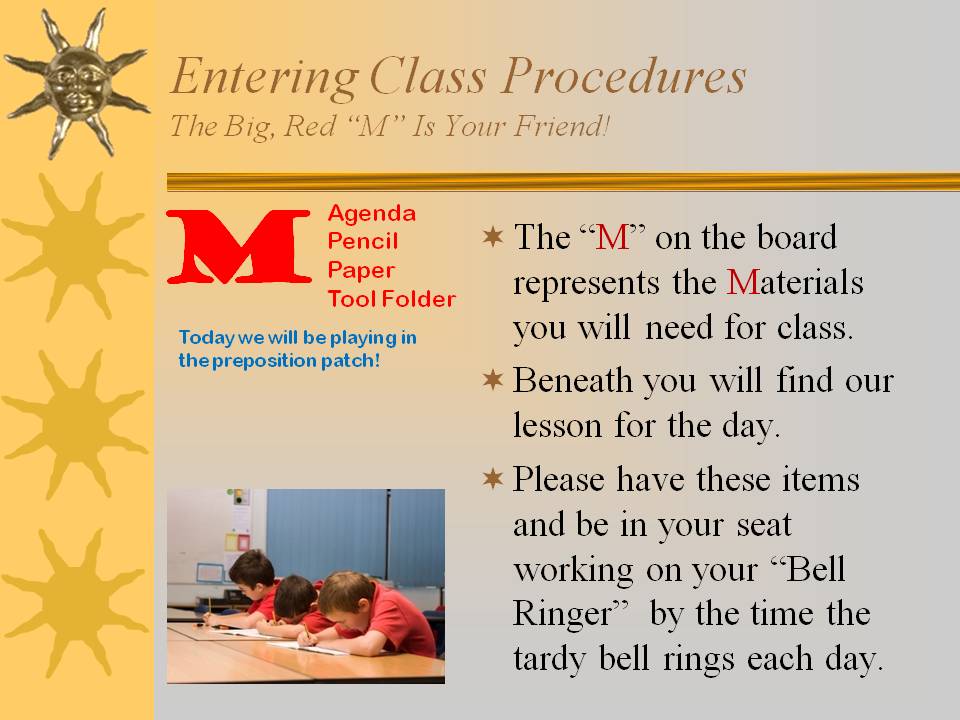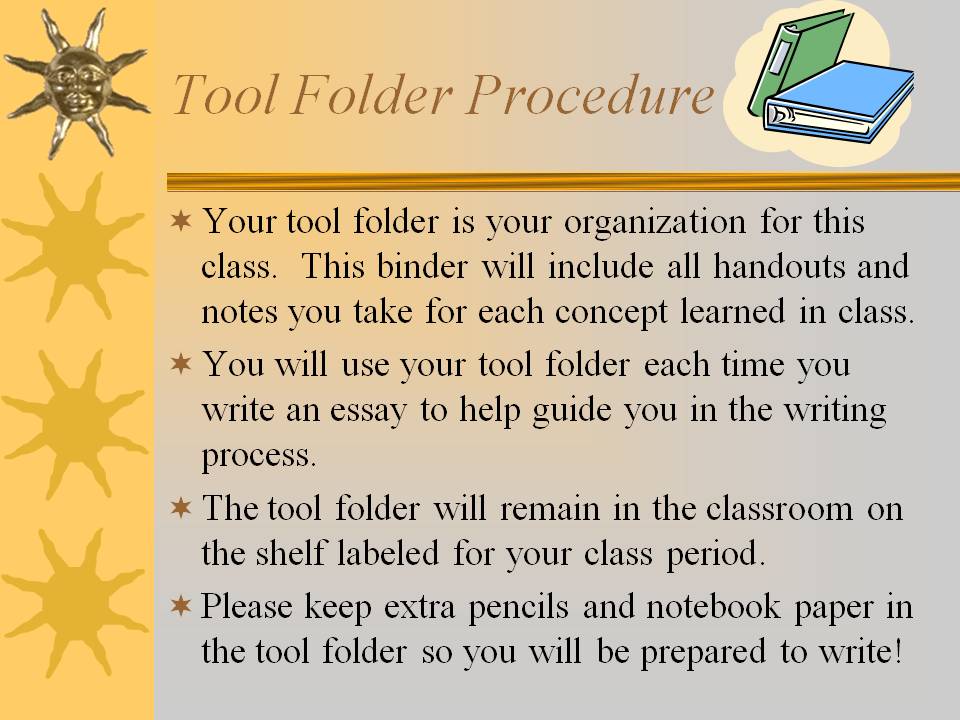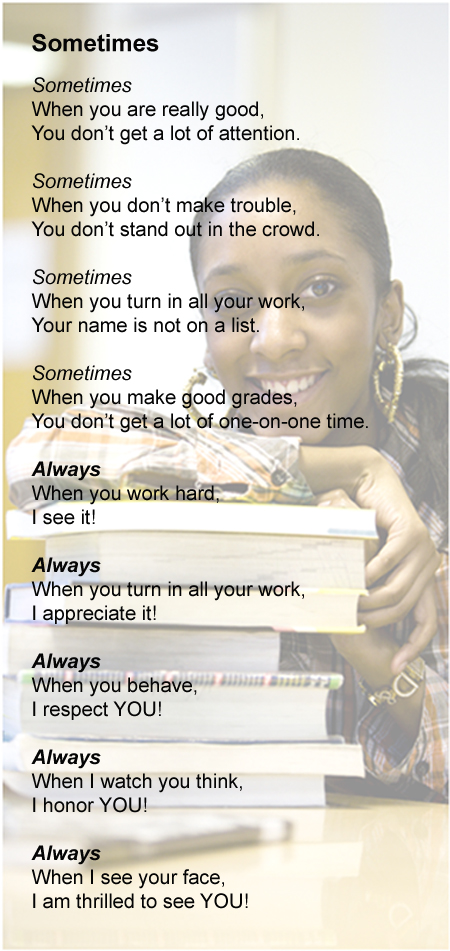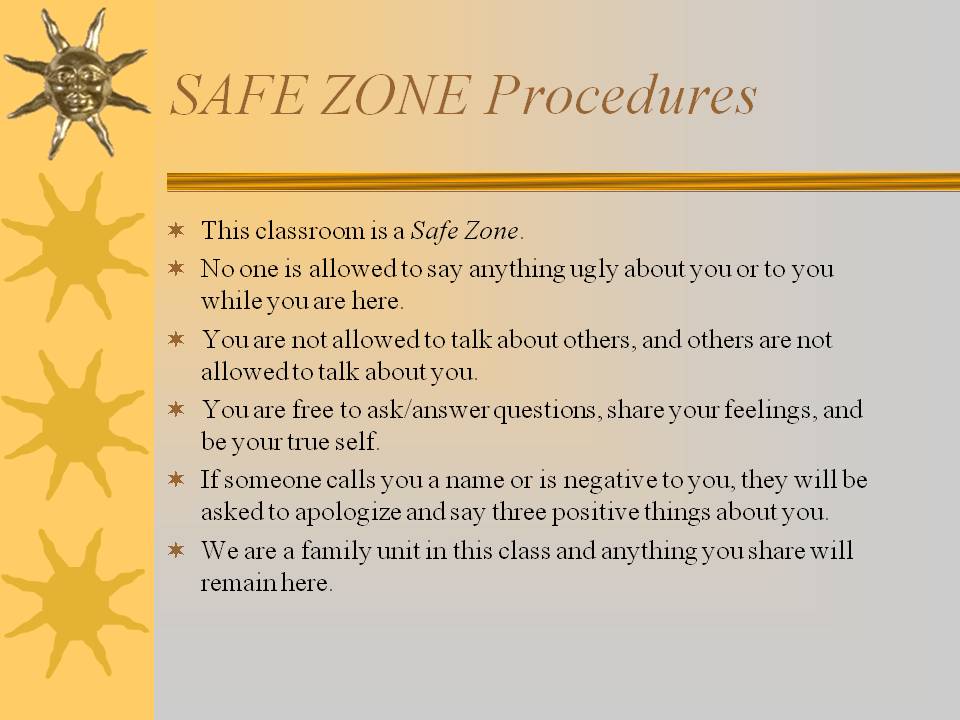
|
Effective Teaching...
by Harry and Rosemary Wong |
To print: Select File and then Print from your browser's menu ------------------------------------------------------------------ This article was printed from Teachers.Net Gazette, located at https://teachers.net. ------------------------------------------------------------------ |
August 2009
Teachers Are the Difference

The First Day Management Plan
Now in her sixth year of teaching, Melissa Dunbar has helped her students achieve a pass rate of between 92%–99% over the years, with her ESL and Economically Disadvantaged students achieving a 100% pass rate this past school year! This seems impossible at a school where the demographics might predict much lower scores:
|
57% Economically Disadvantaged 55.7% At-Risk 11.7% LEP (Limited English Proficiency) 8.3% Mobility |
Melissa’s plan of success for her students begins on the first day of school with a PowerPoint presentation of her classroom management plan. Click here to see Melissa’s first day of school PowerPoint presentation.
The presentation gives her students introductory information on herself—both as a teacher and an individual—and the classroom procedures.
The two crucial elements of organization in her classroom are The Big, Red M and the Tool Folder. She teaches students how to organize their work and their lives so that they can devote their time to learning.
Mollye Williams, Melissa’s principal, once informed Melissa what a couple of her students had shared with her. “Ms. Dunbar is all business. From the time we enter her class, until the time the bell rings, we work!”
On the first day of school, students learn the procedures for entering Melissa’s classroom. They fall into the classroom routine once they cross the threshold of the door. They don’t wait for the tardy bell to ring. They get right to work.
In the same location each day on the class board Melissa has a large red "M" which indicates the materials needed for class. Beneath the M is the learning objective for the day. This eliminates two questions asked by most students:
1. What do we need for class today?
2. Are we doing anything today?
Prior to the tardy bell ringing, the students sharpen pencils, turn in work, obtain materials for class, and begin their bell ringer. (Melissa’s bell ringers are Daily Oral Language, Sustained Silent Reading, Higher Order Thinking Puzzles, or Journal Writing.) This allows Melissa time to greet students at the door and monitor the hallway. Students continue working on their bell ringer until Melissa has taken attendance and begins to teach.


“With procedures in place, teaching feels natural and almost easy. I set boundaries that enable my students to build their own powerhouse of accomplishments,” says Melissa.
Melissa strives to make her students feel safe and relaxed, and emphasizes that it is all right to ask questions.
The Classroom Is a Safe Zone
In Melissa’s classroom, there is peaceful music playing, as well as a 75-gallon fish tank that soothes students through visual and auditory stimulation. There are also blue lights that decrease glare and help students with Irlen syndrome, a perceptual problem that prevents an estimated 10-12% of the population from being able to learn, read, or study efficiently. See www.irlen.com for more information.
There is a large sign on the wall that indicates that the room is a “Safe Zone.” The Safe Zone concept is elaborated on at the beginning of the year: The children are safe to express themselves, ask questions, and be the twelve-year-old children that they are.
This concept catches on quickly: “I can’t tell you how many times I have heard students say, ‘You can’t talk to me like that, this is a Safe Zone!’” says Melissa. The offending student must then say three nice things about the person they offended. This stops the insults and gives students the opportunity to stand up for themselves and others—knowing their teacher will back up them.
Melissa says, “I share real life stories with them to try to get them to THINK. At this age, children often do not think past the immediate moment. It is important to guide them through thinking about the consequences of their actions. I spend a lot of time talking to the children about family, love, and I believe, and sincerely hope, they are more in tune with who they are by the time they leave my class.”
Teamwork Makes a Difference
Melissa’s teaching team meets frequently. They have lunch together daily to discuss the children, cross-curricular opportunities, and ways to improve both the children’s education and the teachers’ teaching.
They are committed to creating a cohesive plan of action.
It was through teamwork, Melissa says, that the bar for the Annual Yearly Progress in math scores at Comfort Middle School was raised. “I am really proud of our school and the way we worked together. We did not make AYP last year for math, so we all worked hard as a team to get the math scores up—and we did!”
Difference Makers
Melissa has a philosophy: “I work at being a leader of leaders. If it falls within my areas of strength, or if something affects me professionally—I am involved. If I can make a positive difference through my talents and knowledge for my students—I am involved.
“I have the mindset that if I want to voice my opinion about what works and what could work better, then I need to be willing to jump in and join the ranks of the Difference Makers.
“The Difference Makers are the ones who are busy. They are always studying, researching, and looking for new ways to raise student achievement, create a better school climate, and make what we do as educators more efficient and effective.
“I am energized when I see, touch, and feel
the accomplishments of my hard work.”
Melissa believes children must know what is expected of them in order to complete an assignment successfully, and considers scoring guides or rubrics an important aspect of her teaching. “For writing, I use a rubric that I obtained from a Writing Academy Workshop I attended. It is based on the state writing rubric, but in a language the children can comprehend. I use the free RubiStar tool (http://rubistar.4teachers.org/index.php) for all other rubrics that I need to make for other projects or activities.” See The First Days of School, Chapter 23 for more information.
Melissa also provides support for her students through a webpage on her school’s site that includes the syllabus, classroom procedures, and useful links. These are posted in English and Spanish so students and parents have easy access.
Click here to see Melissa’s classroom webpage.
Melissa says, “I steal from others, especially the Wongs; adapt to the needs of the children; create until I find what works; apologize when I do something wrong; start over on a clean slate every day; make a fool of myself trying to rap the difference in ‘there,’ ‘their,’ and ‘they’re;’ love my students like they are my own children; and teach with a passion.”
Humble Beginnings
Perhaps some of Melissa’s passion stems from her non-traditional beginning.
“When I graduated from high school, I got a job with a bank making $800 a month and thought I was ‘in the money!’ I married, had three children, divorced, and found myself in a pickle. Thank heavens for the Habitat for Humanity home,” says Melissa.
![]()
Habitat for Humanity gave Melissa ’s family a “hand up” in the form of a home which the family put 300 hours of “sweat equity” into building. Melissa took the hand up seriously, and returned to college to pursue her childhood dream of becoming a teacher. Just one semester after graduation, she began teaching with an emergency certification—she had only taken her pedagogy state exam at that time.
“I grew up on a ranch and am the first person in my family to obtain a
college degree,” says Melissa, “My father was so proud of me. I will never
forget the look on his face when I turned to him, handed him my degree,
and said, ‘This is for you, Daddy.’
“Sadly, ten days later, he passed away.
“He never stopped believing in me or my dream to become a teacher.”
It is this same belief that Melissa carries into her classroom for her students, and which prompted her to write and share this poem with them:

Making a Difference

Melissa says, “In the PowerPoint presentation I share with my students at the start of school, I say ‘I can’t’ is the acronym for ‘I Completely Admit I’m Not Trying.’ I am just beside myself when I hear of teachers who have a 50% pass rate on a test and blame the children, or when teachers do not pay enough attention to realize that a child needs to be tested for extra help.”
Last year, Melissa had a student whose father did not value education. The student’s behavior and academic dedication were poor, and he claimed he would drop out of school as soon as possible. Melissa had a conference with his mother and worked on developing a relationship with the child all year—loving him when he did not want to be loved, lovingly scolding him like he were one of her own, and telling him she would never give up on him.
“Always, positive, positive, positive with him,” says Melissa.
When it came time for the Writing TAKS (Texas Assessment of Knowledge) test, the administration allowed the children to stay until they had completed the test. This child stayed till 5:30 pm!
“I am happy to report he passed the TAKS test. These are the intrinsically rewarding moments that keep me going. That, and my undying desire to see 100% of the students pass,” says Melissa.
“I take teaching extremely seriously. It is not a duty or job. I realize how important it was for me to have been given the gift of a strong foundation. I am not in it for the money or the kudos; I am in it to make a difference in the lives of the children.”
On the opening page of The First Days of School, we say,
“Some people go into teaching
because it is a job.
Some people go into teaching
to make a difference.”
Melissa Dunbar is the difference in her students’ lives. She is forever committed to children and their success.
Be the Difference
The new school year is close at hand. As teachers we can close our eyes and hear the footsteps of children trudging through the hallways hoping they will end up in your classroom and you will be that one teacher . . .
who has a never-give-up attitude and
a whole briefcase full of instructional techniques;
who can’t wait for the bell to ring to start each day and
is organized and ready so students know what to do;
who delights in a challenge and
has the expectation that every child is capable of success;
who honors students with dignity and respect and
expects the same in return;
who is patient with works-in-progress and
cares about the outcome;
who wants to be the difference in students’ lives and
IS the difference in theirs.
Choose to be the difference in your students’ lives.
Wishing you a school year filled with hope and dreams come true for you and your students.